Gardening on a budget doesn’t have to be limiting or discouraging. There are lots of ways to keep the cost down, so it’s not so expensive. In this post, I’ll give you tons of cheap and free DIY gardening ideas that anyone can do.
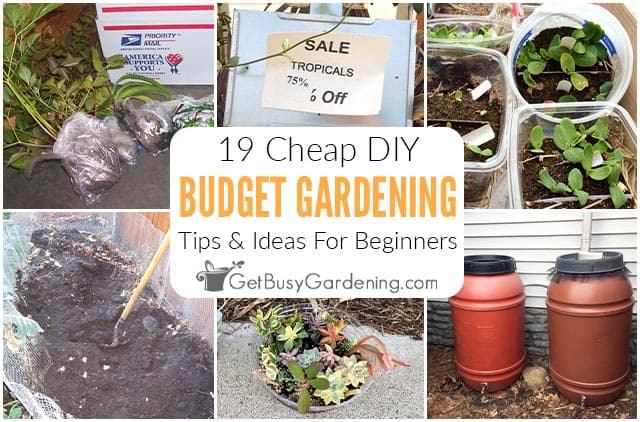
If you’re not careful, gardening can quickly become an expensive hobby. But, it doesn’t have to be. There are tons of ways to garden on a budget and still have beautiful and bountiful beds.
Trust me, I know this first hand. When I started gardening on my own, I was a broke college student. I had to get creative, which means I spent a lot of time finding ways to garden on a dime.
Over the years, I’ve become a pro at doing it on the cheap. And now, I’m sharing all of my secrets with you.
So, if you want to start gardening, but have a limited budget, then you’ll find tons of great ideas on this list!
Tips For Gardening On A Budget
The good news is that there are tons of easy ways to garden on a budget. Here’s a list of a few of my favorite ways to pinch pennies.
1. Grow From Seeds
You can stretch your gardening budget much farther when you grow your own vegetables, annuals, and perennials from seed.
If you’re a beginner look for ones that are easy to start from seeds. Many can be planted directly in the ground so you won’t need to buy any expensive equipment.
2. Find Used (Or Free) Tools & Equipment
Don’t buy your tools and equipment brand new, getting them used will save you tons of cash.
It’s easy to find used tools for pennies on the dollar, or even free, at garage and yard sales, or online marketplaces.
Also, ask your friends and neighbors to see if they have anything you can borrow. Heck, they may even have stuff collecting dust in the garage that they would be happy to get rid of.
Related Post: 21+ Essential Tools That Every Gardener Needs
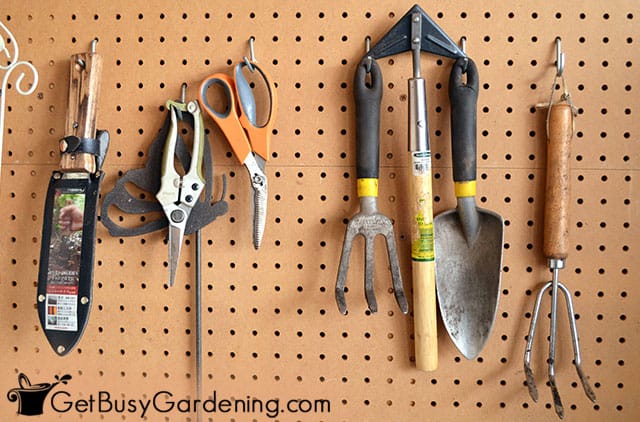
3. Collect & Save Seeds
Every budget-wise gardener should definitely learn how to collect seeds. There are tons of different types of perennials, annuals, and even veggie seeds that you can gather for free from your own garden.
This way, you won’t have to spend money to purchase any new ones, and you can build up a nice variety to regrow year after year.
Also, make sure to keep the extras of any that you’ve purchased. Seed packets usually come with more than you need. As long as you store them properly, you can keep most of them for several years.
4. Participate In Seed Swaps
The fastest way to build up a large stash of garden seeds when you’re on a budget is to trade for them. If you participate in local swaps, or organize a trade with friends, then you won’t have to spend any cash.
Otherwise, there are entire websites, forums, and social media groups dedicated to trading seeds online for merely the price of postage.
Sometimes you can find people who are generous enough to give them to you, even if you don’t have any to trade. Then once you build up a nice stash, you can pay it forward.
If you are just starting out, and don’t have any to trade, find a friend or two and go shopping together. You can pool your money to buy a larger variety, then divvy them up.
5. Repurpose & Upcycle
There are tons of ways to save money on your garden by upcycling items you already have or can easily find for free.
The possibilities are only limited by your imagination. Here are a few of my favorite thrifty ideas..
- Repurpose lumber or bricks to use for edging your garden beds.
- Raid your recycling bin, and use clear plastic food containers to start seeds.
- Build trellises out of scrap wood or metal.
- Make DIY plant markers out of old vinyl mini blinds.
- Get creative by making your own garden art out of repurposed junk.
- Hang an old mirror or chandelier to add a touch of shabby chic to your garden.
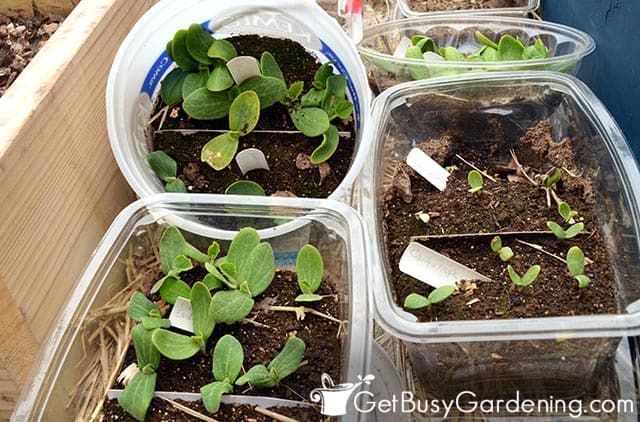
6. Don’t Throw It, Grow It!
Many discarded kitchen scraps can be used to grow new plants by saving the seeds or root stalks, even from grocery store produce.
This is very easy to do with vegetables like peppers, potatoes, garlic, onions, lettuce, celery, and carrots.
7. Take Cuttings & Divisions
Rather than buying plants, take cuttings and divisions of the ones you already have. This is called plant propagation, and it’s a gardening technique that anyone on a budget should learn.
It’s by far the most cost effective way to create new beds, expand existing ones, or even to fill your summer containers. There are tons of plants that are super easy to propagate, and you won’t have to spend a dime.
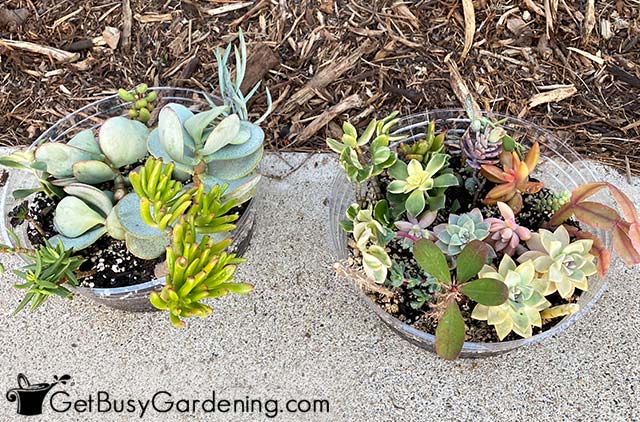
8. Look For Free & Inexpensive Plants
Seasoned gardeners always have a surplus of plants they are eager to give away. Oftentimes, you can find inexpensive options at Farmers Markets or in online marketplaces.
Look for sales around the neighborhood or your local community. Sometimes schools and universities will host them too.
Also, ask your friends and neighbors to see if they have anything they would be willing to divide and share with you. Once you build up your garden, you’ll be able to return the favor.
9. Buy Small Starter Plants
Rather than buying large, established perennials, purchase plugs instead. You can usually get a whole flat of smaller plugs for much less than it would be for one or two mature plants.
That means you can fill an entire garden bed for a fraction of the price, and stay within your budget. Yes, it will take a bit longer for them to fill in, but the cost savings will be worth the wait.
10. Wait For Plants To Go On Sale
New plants are the most expensive in the spring because everyone is eager to get their garden going.
So wait until after the initial rush to buy them. I know it’s hard not to get caught up in the excitement after the long, cold winter, but you won’t have to wait too long.
Oftentimes, garden centers will put them on sale as soon as the heat of summer kicks in. Fall is also a great time to find them at deep discounts.
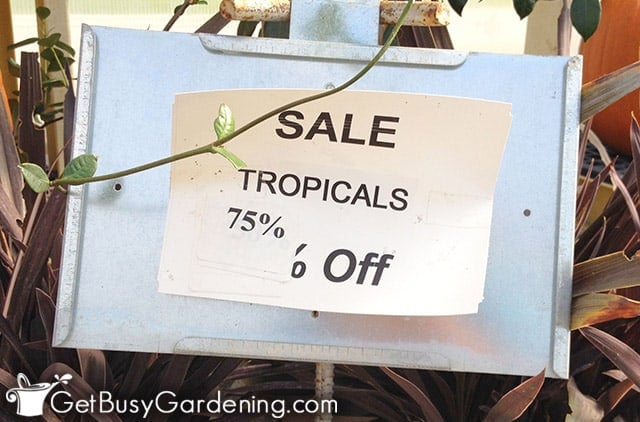
11. Shop End-Of-Season Sales
Just like anything else, gardening tools and equipment are usually cheaper to buy at the end of the season.
During late summer and early fall, stores are trying to clear space to make room for the next season of goods.
This is the best time to shop for cheap tools, gloves, pots, supplies, equipment, and even plants.
12. Make Your Own Compost
Compost is a great soil enhancement, and it’s something you can make yourself. You don’t need to buy a fancy bin or tumbler either.
Simply create a dedicated pile, or make a bin out of repurposed fencing or chicken wire. Put it right in your vegetable garden so spreading all that free black gold is a breeze.
Check with your city or county too. These days, many of them have inexpensive, or even free, compost available to their residents.
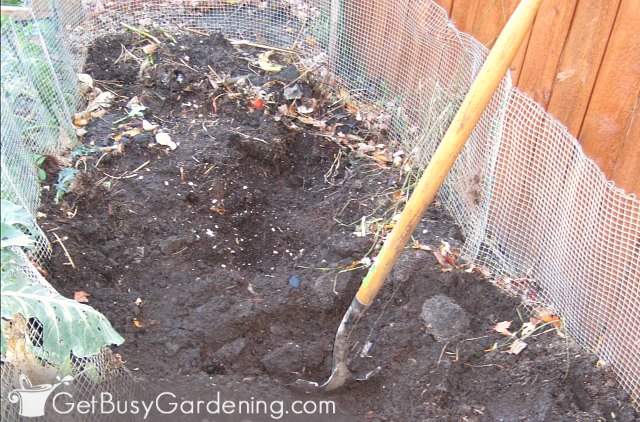
13. Exchange Seedlings With Friends
I don’t know about you, but I always end up with more seedlings than I have room for in my garden.
If you find yourself with extras, don’t just toss them out, swap them with your friends and neighbors to expand your collection for free.
14. Grow Organically
Using chemicals is expensive and totally unnecessary. Skip the costly, harmful pesticides, fertilizers, and herbicides, and grow organically instead.
Not only will it fit your tight budget, but your garden will be much healthier. You can easily make your own natural remedies and organic pest deterrents using supplies you already have, or from inexpensive ingredients.
15. Trade Plants
Everyone has plants that can be divided and traded for new ones. So if you want more variety in your garden this year, but don’t have a big budget, then get out your shovel.
Divide some of your existing perennials to trade for others. You could even organize a plant swap in your community or join dedicated groups online.
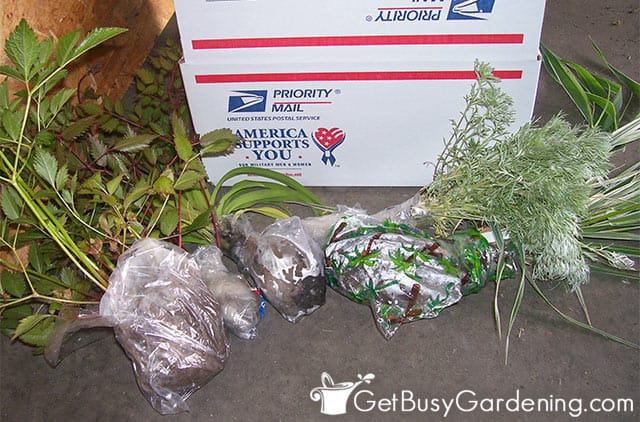
16. Overwinter Plants Indoors
It’s crazy how many of the annuals sold in stores are actually tender perennials that can live for many years in warmer climates.
Many types of tropicals, annual flowers, herbs, and even some veggies can easily be overwintered indoors. It’s totally worth the effort, and you won’t have to spend money buying new ones every spring.
17. Collect Rainwater
Not only will collecting rainwater save on your water bill, it’s also better for your plants, and good for the environment too.
Rainwater can be used in your outdoor beds or inside on your houseplants. In the winter, you can melt snow to water your indoor plants, which is just as good.
A rain barrel can be expensive, but you can save money by making your own. Many cities even have programs where they sell them at deep discounts to encourage residents to use recycled water.
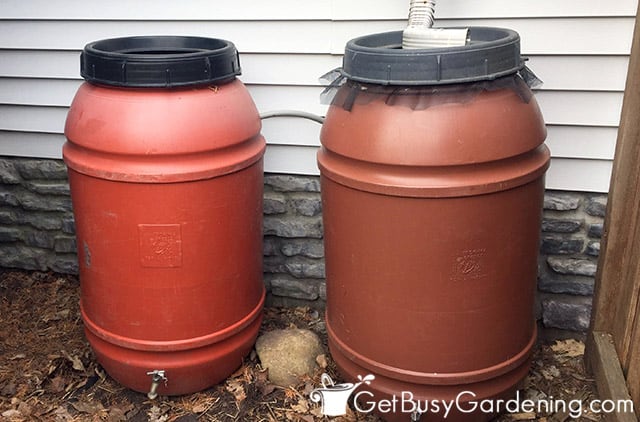
18. Choose Low Maintenance Plants
High maintenance plants are more expensive to buy than native ones or varieties that are common in your area. Plus, it also costs more money (and effort) to take care of them.
You’ll find that high maintenance varieties require more water, expensive soil amendments, fertilizer, and/or pest control.
Choosing ones that are hardy to your growing zone and climate instead will save you money in both the short and long term.
19. Saving & Using Leaves
Whether you’re on a budget or not, leaves are like gold to gardeners. They are an excellent mulch, add nutrients to the soil as they break down, and protect plants in winter. Best of all – they’re free!
So save the leaves from your yard, and gather them from your neighbors too. Then use them to cover your beds and top off the compost heap.
Gardening doesn’t have to be expensive, you can fit it into any budget. Give a few of these ideas a try, and you’ll see just how easy it is to save yourself some cash. Then you’ll soon be a pro at thinking of other ways you can make gardening even cheaper.
More About Budget Gardening
- How To Safely Buy Used Canning Supplies & Equipment
- A Cheap Alternative To Coconut Liners For Hanging Baskets & Planters
- A Cheap & Easy Propagation Box For Rooting Cuttings
Share your favorite ways to garden on a budget in the comments section below.
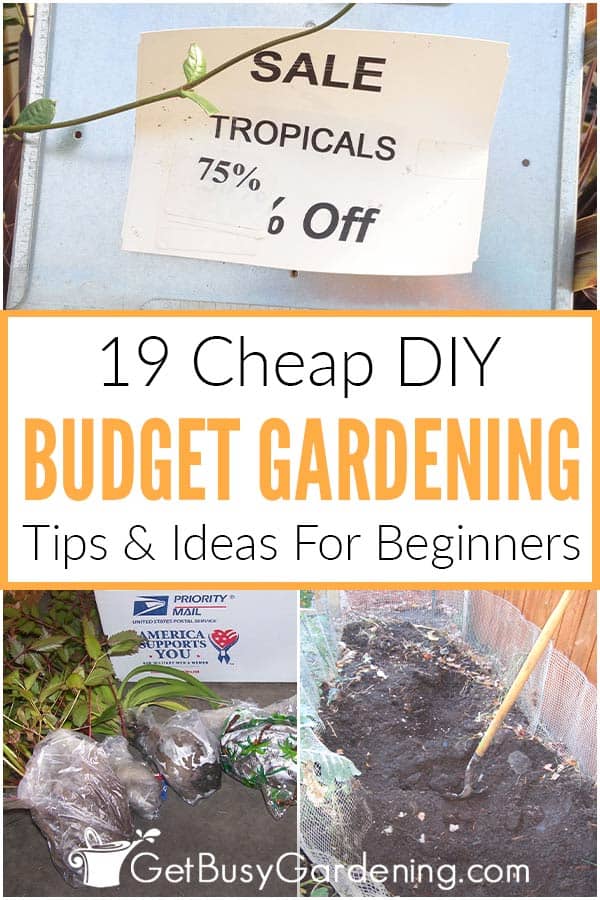
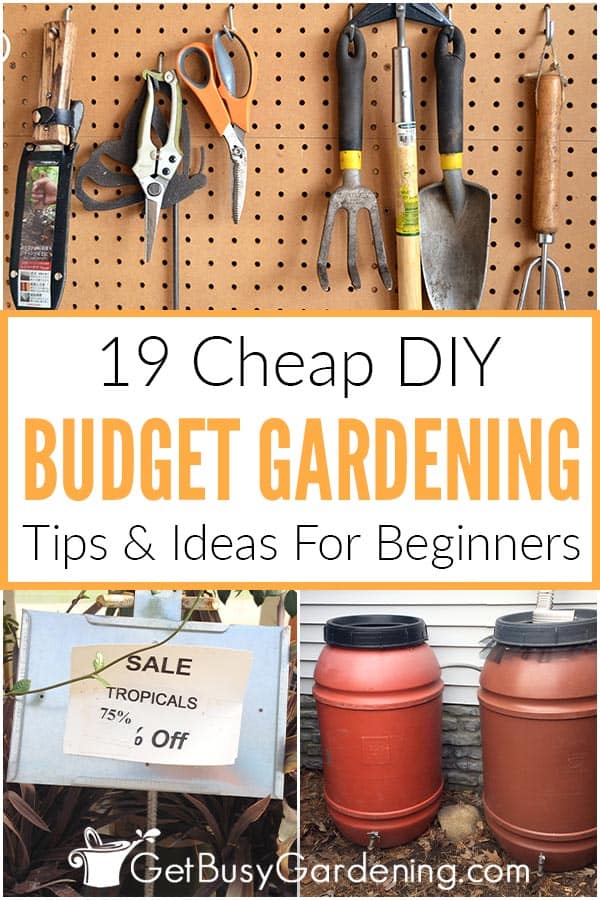



Carole Coates says
I wanted to share some of the ways we’ve recycled in the garden to save money. We wired a couple of old metal store display units together to make an A-frame trellis. They were supporting a vigorous gourd plant a couple of years ago. We’ve also reused several items from a major diy home rehab project. Did some terracing (we’re on a mountainside) using old pine siding boards to hold everything in place. We removed the glass from an old storm door and inserted homemade lattice for a gate (I think we need to add a little “Welcome” sign to perk it up a bit). We’ve also used former fence material to make a bean arch and t-posts from the fence for various supports throughout the garden. Love recycling in the garden.
Amy Andrychowicz says
Oh, these are fabulous ideas!! You’re such a clever ‘upcycler’! 🙂 Thank you so much for sharing all of the ways you recycle everyday items in your garden.
ana says
i have been reading books about victory gardens and wartime gardening for food. a lot of what they did then applies today in terms of maximizing the use of space on a limited budget and resources. very inspiring to read about how things were not so long ago! your tips are great (i really enjoy this blog!). thanks for sharing your tips and experience!
Amy Andrychowicz says
Sounds very cool. We can learn a lot from history, and how they stretched every dollar back then to save money growing their own food. Thanks for sharing about the books you’re reading, I’ll have to check them out.
Nugget says
My neighborhood has a plant swap every spring. Even if you don’t bring any plants, you can buy them for $1 each. Can’t beat that price! I’ve gotten siberian iris, coneflower, sedum, hellebore, crepe myrtle, ironweed, and more!
Amy Andrychowicz says
Oh wow, how wonderful! I love this idea, and what a great way to get plants for pennies on the dollar. Thanks for sharing.
Heather Williams says
We’re just starting out with a garden at this farm, and although I know it’s expensive this year, I also know that I will save a TON of money next year and years beyond. We have bought a tiller, dumptruck of compost and a ton of seeds. We’ll have about 1/4 acre and are on a 5 year plan to grow/raise 80% of our own food in the yard ? I love the idea of going to garage sales for tools!
Amy Andrychowicz says
Gardening can be an investment at first for sure. Wow, you guys have such a great goal!! Growing 80% of your own food, that would be amazing!
El Gaucho says
Very interesting. I think people tend to underestimate how expensive gardening CAN be, and lose sight of how cheaply things can be done once the first few years of acquiring tools/hardscape/infrastructure.
My biggest takeway over the years is also how much stuff is out there for free or very cheap. Tools, pots, mulch, compost, etc. can be found in so many places with a little computer effort and some hustle.
Amy Andrychowicz says
Great point, I totally agree! I bought most of my gardening tools at garage sales too. I am just like you, I get all of my garden stuff for either free or very cheap. I love going to garage sales, and most people are ready to practically give away the garden stuff. Now that my vegetable garden is established, I hardly spend any money on it. I grow everything from seed that I either collect or trade for only the cost of postage. So, it’s practically free. I only wish I could grow stuff year round.
Jan says
Hi Amy, I really enjoyed all of your great ideas for budget gardeners like myself! I especially love the idea of using old blinds for markers, genius!
Amy Andrychowicz says
Wonderful! So glad to hear that a fellow budget-wise gardener enjoyed my tips. 🙂
FlowerLady says
What a great list of ideas. I do use mini blinds for plant markers with pencil. We are ‘curbside shopper’ and have found and use a lot of cool stuff that was headed for the landfill.
Amy Andrychowicz says
Awesome ways to save money on gardening, and keep all that stuff out of the landfill! Great work!
Michelle says
Shop for perennials at the END of the season. They may look ratty or even be dormant, but they are also much cheaper on clearance. A local public garden here even has a “trunk load” sale at th end of October – everything you can fit in your car for a donation to the garden. Plant in fall and then in spring they will come back to life good as new – or even better!
Amy Andrychowicz says
Oooo, great tip!! I love the trunk sale idea, I wish I lived near you! LOL!
Zac Spade says
Thanks for the tips Amy,
I have found using empty juice and soda bottles are also a good place to start seeds
Amy Andrychowicz says
You’re welcome, and thanks for adding your own tip! 🙂
Marge says
Hi Amy! Great article and I love your blog! One thing I learned early on was to not buy seeds from expensive seed catalogs! They’re fine for really special things, but boy it’s easy to spend a lot of money. I found a local hardware store where they buy seeds in bulk and then repackage them to sell in their store. It’s so much less expensive! And normally there’s a lot more than I’ll use in one package, but that’s okay. I keep them in the freezer and they stay good for a few years. The seed companies aren’t going to tell you that, I don’t think. 🙂
Stopping by from You’re Gonna Love It Tuesday.
Amy Andrychowicz says
Great tip, thanks for sharing!
Crystal says
Thanks for all the gardening tips! I’m not a gardener at all, but my son seems to be learning pretty fast. I can’t wait to share some of the great ideas you have shared on the blog.
Amy Andrychowicz says
You’re welcome, thanks for sharing!
vicki says
Another great resource is freecycle. People post all kinds of things, like plants they are splitting, garden tools cause their moving or downsizing and it’s local.
Amy Andrychowicz says
Yes, thanks for mentioning it!
salvacion cipcon garhitorena says
I used to poduce seeds from my plant for the next planting season
Tara says
I wash all my dishes by hand in dish pans and then use that water to water all my plants. The water has food waste in it which is good for the plants and dawn (I only use dawn) dish washing detergent that the bugs hate. I also have my washer dump into a “rain barrel” and use that water on my yard and plants.
Amy Andrychowicz says
Wow, those are all great ideas!! Thanks for sharing your tips!
Amy
Laura @ Raise Your Garden says
Hi Amy!
I also recycle water by emptying the kiddy pools into the garden. The kids love to help in this way…and the water gets icky after 2 days so it needs to get dumped!
I save money also by making a lot of my own compost from my kitchen fruit and veggie scrapes since we eat mostly a plant-based diet.
Mandy says
One of the little ways I save money, but moreover, save the planet is to use the left over water from my childrens’ water cups and water bottles from school or water from the dog bowls to water my plants.
Also, vinegar is a great weed killer. It is much cheaper than store weed killers and better for the environment.
Amy Andrychowicz says
Wow, you are dedicated Mandy! I use the water from water bottles to water my indoor plants too. But I need to be better about taking them outside to the garden in the summer rather than dumping them down the drain. Wonderful ideas!
Amber says
I also collect leftover water from abandoned drinks and the cat bowls throughout the week in a watering can underneath the sink. I even save water from boiling eggs and from other random kitchen uses. Every little bit helps!
Amy Andrychowicz says
Great ideas!! Thanks for sharing.
becki says
does vinegar kill the plants too?
Amy Andrychowicz says
Yes it can, so definitely keep it off the plants you don’t want to kill.